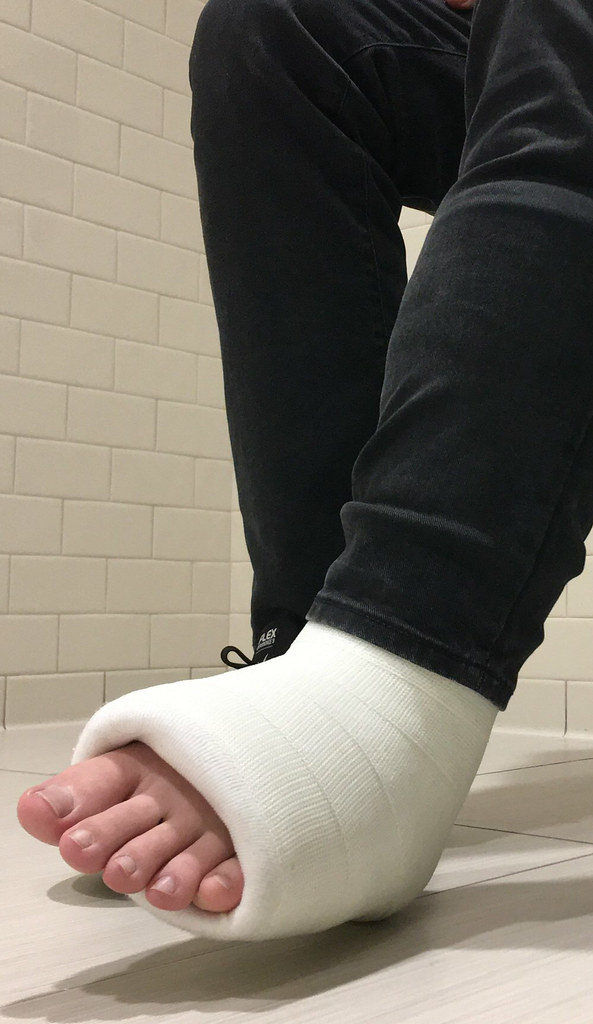#achillestendon
Text
Some people have mentioned that they liked my casts from my Achilles tendon injury of 2022. So I posted quite a few on this link!
http://castandcrutches.com/achillestrek.html
#castandcrutches#crippled#crutches#legcast#leg cast#on crutches#sprainedankle#ankle injury#ankle sprain#cast and crutches#sprained#sprained ankle#achillesruptured#achillestendon#achilles#brokenleg#brokenankle#toes#castedleg#castedfoot
68 notes
·
View notes
Text

🔰BOS RISING STAR
An Initiative of Bombay Orthopaedic Society to provide platform to Young Orthopods
🔆 FIERY FOOT & ANKLE SESSION
🔆Date & Time : 13th October - 8.00 PM
🔆Click to Watch
BOS YouTube: https://m.youtube.com/live/vWsh_lr8srM?
OrthoTV: https://tinyurl.com/OrthoTV-BOS-6
👨⚕️ Dr. Gaurav Ranglani
Lisfrancs Fractures: Review of Current Treatment methods
👨⚕️ Dr. Chandan Narang
Achilles Tendon Repair: A review of surgical approaches
👨⚕️ Dr. Pulkit Bandi
Management of Calcaneal Fractures: Review of Surgical approaches
👩⚕Dr. Sheenam bansal
Surgical Treatment of Tarsal Coalition: Current techniques and outcomes
Conceptualised by
Dr. Sanjay Dhar President - Bombay Orthopaedic Society
Dr. Neeraj Bijlani Secretary - Bombay Orthopaedic Society
Dr. Ashok Shyam Coordinator - BOS Rising Star
Supported by
🤝OrthoTV Team: Dr Ashok Shyam, Dr Neeraj Bijlani
📺 Streaming live on OrthoTV
www.orthotvonline.com
▶️ Join OrthoTV - https://linktr.ee/OrthoTV
#BOSRisingStar#Orthopedics#FootAndAnkle#OrthoTV#BombayOrthopaedicSociety#OrthopedicSurgeons#MedicalEducation#SurgicalTechniques#OrthopedicTreatment#Fractures#AchillesTendon#CalcanealFractures#TarsalCoalition#MedicalLearning#MedicalCommunity#OrthoLearning#OrthopedicExperts#SurgicalApproaches#MedicalWebinar#HealthcareEducation#MedicalDiscussion#OrthopedicTopics#YoungOrthopods#MedicalEvent#OrthoEducation
0 notes
Text
Drop Jump Exercise (1 Foot) | Shock Training Plyometrics

Drop Jump Exercise (1 Foot) | Shock Training Plyometrics Most people focus on plyometrics that involve jumping to higher and higher boxes trying to get more explosive. Drop Jump Exercises focus on the landing of the movement instead of the actual jump itself. What people forget about is that no matter the height of the jump you make, you'll always have to land from that jump. And if you do not feel comfortable landing from that jump, then you'll only have so many jumps before you start to feel tendon pain or injury. Shock training plyometrics are great for the health of the tendons that you use in support. Mainly the Achilles and patellar tendon. Drop jump landings should be included in the majority of peoples programs as it can be scaled appropriately to many ages!
#Plyometrics#ShockTraining#JumpTraining#TendonHealth#DropJumpExercises#ExplosiveLandings#InjuryPrevention#AchillesTendon#PatellarTendon#FitnessForAllAges
0 notes
Text
What Is Prestressed Concrete & Advantages and Disadvantages of Prestressed Concrete

What Is Prestressed Concrete?
Prestressed Concrete is simply concrete that is stressed before concrete is poured in from work with the help of a jack and tension embed in it.
In the case of prestressed concrete, high-strength prestressed steel bars produce tension in a concrete member before actual loads are applied which will be balanced by the tensile stresses imposed on the member during the service period or after commissioning.
As we generally know that concrete is the mixture of three main ingredients which are cement (a fine mixture of clay, limestone, and a small amount of gypsum ground up to the desired degree of fineness), sand (only river sand or obtained through pit) and aggregate (Made form blasting and grinding from rocky soil) and when we add water (free from impurities) in this mixture it creates concrete which we use for various civil work.

Prestressed Concrete
One of the main important characteristics of concrete or drawback of concrete is, that it is weak in tension and strong in compression because the material used in concrete is rigid and posse’s low tensile/flexural strength.
That’s why in order to resist the tensile load or stress which structure has to resist after actual loading.
Engineers come up with a solution to introducing High strength steel bars into concrete members. Using this method they have overcome the problem of tensile stress which has allowed the engineer to achieve various possibilities such as reducing the size of members increasing span length etc.
But when we consider structure such as bridges, where the span is so long and the load is also high, we can’t simply adopt a normal reinforced concrete structure as the size of the member become larger, crack developed and it’s become uneconomical.
Under such a circumstance we have to adopt different kinds of methods and one of the most commonly adopted methods is the prestressing of concrete.
Read More: Self Healing Concrete- A New Innovation In Civil Engineering
Prestressed Concrete Structures
Conventional concrete has embedded with high tensile strength steel bars which have great compressive strength to form ideal structural material which is good in both compression and tensile.
In the case of prestressed concrete, high-strength prestressed steel bars produce tension in a concrete member before actual loads are applied which will be balanced by the tensile stresses imposed on the member during the service period or after commissioning.
As you can see in fig. 1 which is a normal R.C.C beam where no prestressing is done beam will deflect under loading and the crack will develop.
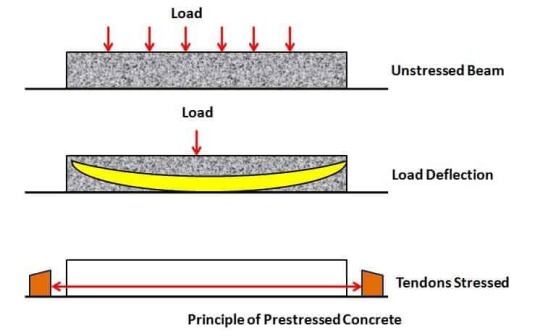
Principle of Prestressed Concrete

Principle of Prestressed Concrete
- Where in fig. 3 to 6 you can see that if we apply pre-stress force before actual loading, we will see a positive deflection caused by applied compression force but as the actual load is applied to the beam our beam will become straight or flat.
- Some of the benefits of prestressed concrete over conventional R.C.C is that we can construct members having less crack, less shrinkage, and temperature effects.
- As a result, the ingression of detrimental agents is prevented which helps in avoiding reinforcement corrosion.
- It is also becoming a tool to go beyond the design limitation of concrete members placed on span and load and permits the building of roofs, floors, bridges, and walls with longer unsupported spans.
- This allows architects and engineers to design and build lighter and reduce its C/S area without losing strength but the construction process in prestressed concrete requires extensive monitoring and complicated devices and equipment at all stages.
Read More: What is Curing of Concrete and Different Methods of Curing
Tendons In Prestressed Concrete

Prestress Tendons
Steel Wires - wire is a single unit made of steel.
Strands – Group of wire not more than 7 wounded to form a prestressing strand.
Tendon – A number of strands or wires are packaged together to form a prestressing tendon.
Cable – When a number of tendons are grouped together and form a single wire then it is called a Cable.
Based upon the concrete-steel interface it can be classified into two-part:
Unbounded tendon – This tendon is one that is not bonded or in which no concrete grouting is done after prestressing.
Bonded tendon - This tendon is bounded by injecting concrete grout.
Types of Prestressed Concrete
1. Pre-tensioning

Pre-tensioning of Concrete
In the pre-tensioning process, the steel tendon is stretched before the concrete is poured into the formwork.
Then High-strength steel tendons are placed between two abutments and stretched as per the required deflection or strength.
After that Concrete is poured into molds and around the tendons and allowed to cure. Tendons are kept stretched until the desired concrete strength is reached after curing.
As the steel reacts to regain its original length, the tensile stresses are translated into compressive stress in the concrete.
The most popular prestressed concrete elements are roof slabs, piles, poles, bridge girders, wall panels, and railroad ties.
Read More: How Long Should Concrete Cure Before Removing Forms
2. Post-tensioning

Post-Tensioning
In the post-tensioning process tendons are stretched after the concrete hardens. First, Concrete is cast around, but not in contact with unstretched tendons. In many situations, a duct is formed in the concrete unit using thin-walled steel forms.
As the concrete hardened to the required strength, the steel tendons are then inserted and stretched against the ends of the unit and anchored off externally, placing the concrete into compression.
Post-tensioned concrete is used for cast-in-place concrete and for bridges, large girders, floor slabs, shells, roofs, and pavements.
Principles of Prestressed Concrete
In concrete, a large prestressing force is applied by tendons embedded into it to develop high bearing stresses at the ends by the anchoring devices. These anchoring devices are generally designed for high-strength concrete work.
Too high tensile stresses are likely to be developing in concrete members and that cannot be satisfactorily resisted by low-strength concrete work.
Stress transfer to concrete is done by and between concrete and tendons, the concrete should have a high strength concrete.
Shrinkage cracks will occur during the safer of stresses from tendon to concrete.
High-strength concrete has a high modulus of elasticity and therefore the elastic and creep strain are very small resulting in a smaller loss of pre-stress in all steel reinforcement.
Read More: Concrete Crack Repair – Top 5 Best Methods Of Crack Repair
Advantages and Disadvantages of Prestressed Concrete
Advantages of Prestressed Concrete
- We can achieve the overall economy as by adopting prestressing we can reduce the of the er for higher load smaller C/S can be achieved.
- A large span can be achieved without increasing the member size for the same loading condition.
- Other advantages, such as excellent fire resistance, low maintenance costs, elegance, high corrosion resistance, adaptability, etc.
- By adopting prestressed concrete we can achieve a structure that will have less crack or crack-free structure.
- Because of better material being used and nullifying the effect of dead loads, smaller deflections are caused.
Disadvantages of Prestressed Concrete
- The cost of high-strength materials being used is higher than the normal RCC.
- The initial cost is incurred due to the prestressing equipment and its installation.
- Excessive cost for prestressing is also there.
- Prestressing is uneconomical for short spans and light loads.
FAQs:
Prestressed Concrete DefinitionPrestressed Concrete is simply concrete that is stressed before concrete is poured in from work with the help of jack and tension embed in it. In the case of prestressed concrete, high-strength prestressed steel bars produce tension in a concrete member before actual loads are applied which will be balanced by the tensile stresses imposed in the member during the service period or after commissioning.What Is PrestressingPrestressing is the process of compressing concrete element by steel wires or strands. Precast concretet elements can be prestressed during the construction process (pre-tensioning) or structures may be stressed once completed (post-tensioning). Prestressing counterbalance the tensile stresses introduced when the element is loaded. Hence the concrete element remains in compression.Prestressed Concrete StructuresPrestressed concrete structures are constructed from pre-stressed concrete elements. Precast concrete elements can be prestressed during the construction process (pre-tensioning) or structures may be stressed once completed (post-tensioning). Prestressing counterbalance the tensile stresses introduced when the element is loaded. Hence the concrete element remains in compression.
You May Also Like
- What Next, If Concrete Cubes Failed After 28 Days
- Concrete Curing Methods
- Concrete Mix Design Step By Step Full Calculation
- How To Check Compressive Strength Of Concrete
Read the full article
#achillestendon#advantagesanddisadvantagesofpretensioningandposttensioning#advantagesofprestressedconcrete#advantagesofprestressedconcreteoverrcc#advantagesofprestressedconcreteoverreinforcedconcrete#advantagesofpsc#applicationofprestressedconcrete#concreteprestressing#designofprestressedconcrete#disadvantagesofprestressedconcrete#mechanicalpropertiesofprestressedconcrete#methodsofprestressing#methodsofprestressingconcrete#methodsofprestressingppt#pcidesignhandbookprecastandprestressedconcrete7thedition#posttension#posttensionedprestressedconcrete#posttensioning#post-tesion#pretensioningandposttensioning#pretensioningsystem#pre-stressedconcrete#pre-tesion#precastprestressedconcrete#prestresscable#prestressconcrete#prestresstendon#prestressedconcrete#prestressedconcretebook#prestressedconcretebridge
0 notes
Photo
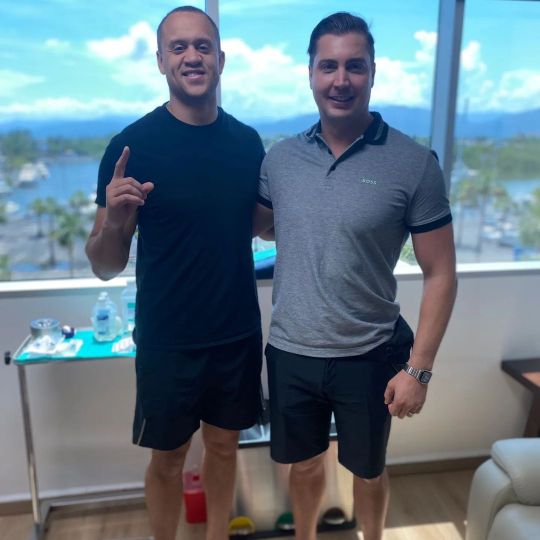
Fixed up the Achilles Tendon of Adam from the Dream Chasers podcast with 50 million mesenchymal stem cells at www.dreambody.clinic #dreamchasers #stemcell #stemcells #stemcelltherapy #achillestendon #tendonitis #heal #dreambodyclinic #regenerativemedicine https://www.instagram.com/p/CgxQAm-O8rB/?igshid=NGJjMDIxMWI=
#dreamchasers#stemcell#stemcells#stemcelltherapy#achillestendon#tendonitis#heal#dreambodyclinic#regenerativemedicine
0 notes
Video
SUFFERING FROM FOOT PAIN? 🦶😢 👉 Have you been diagnosed with Plantar Fasciitis, Achilles and Plantar Tendonitis, Bone spur, Calf or Heel Pain, Numbness in the toes, or Arthritis of the ankle or feet? Then you might want to take advantage of our “ARCH MADNESS” Foot Pain Relief offer. 👏 👏 Exam and 1st session for only $97. ✅ That’s a savings of $65 to $75. Why wait any longer? Call today at 604-535-7373 or learn more online at https://bit.ly/3sRahC6
#numbnessinmytoes#plantarfasciitis#Custom#Custommadeorthotics#whymyfeethurt#archmadness#foot#achillestendonitis#Orthotics#footpain#physionearme#chiropractornearme#bestplacefororthotics#heelpain
1 note
·
View note
Link
#achillestendonitis#footorthotics#gaitscan#iliotibialbandsyndrome#marathon#massage#plantarfasciitis#runnersknee#running#runninginjuries#shinsplints#softtissuetherapy#sportsmassage
0 notes
Text
Achilles tendinitis

Overview
Achilles tendinitis is a condition that occurs when the Achilles tendon, which connects the calf muscles to the heel bone, becomes inflamed. This can cause pain and stiffness in the back of the ankle and can make it difficult to walk, run, or perform other activities that involve the lower legs.
The Achilles tendon is one of the strongest and largest tendons in the body, and it plays a critical role in allowing us to move our feet and ankles. However, it is also prone to injury, particularly in athletes and people who engage in activities that involve repetitive jumping or running.
Achilles tendinitis can be caused by a variety of factors, including overuse, improper footwear, tight calf muscles, and sudden increases in physical activity. People who are middle-aged or older, as well as those who are overweight or have certain medical conditions, such as diabetes, are also at an increased risk of developing Achilles tendinitis.
Treatment for Achilles tendinitis typically involves rest, ice, compression, and elevation (RICE), as well as physical therapy exercises to help strengthen the calf muscles and improve flexibility. In some cases, non-steroidal anti-inflammatory drugs (NSAIDs) may be prescribed to help reduce pain and inflammation.
Severe cases of Achilles tendinitis may require more aggressive treatments, such as immobilization in a cast or brace, corticosteroid injections, or even surgery. However, most people are able to recover from Achilles tendinitis with proper treatment and management.
Symptoms
The symptoms of Achilles tendinitis may vary from person to person, but common symptoms include:
- Pain and stiffness in the back of the ankle, especially when walking or running
- Swelling or tenderness in the area around the Achilles tendon
- Difficulty flexing or pointing the foot
- A crunchy or crackling sound when moving the ankle
- Pain that worsens with activity and improves with rest
- Mild to moderate pain after exercise or physical activity
If left untreated, Achilles tendinitis can lead to more serious injuries, such as a ruptured tendon, which may require surgical intervention. If you experience any of the above symptoms, it is important to seek medical attention to determine the best course of treatment.
When to see a doctor
It is recommended to see a doctor if you experience any of the following symptoms:
- Severe pain and swelling in the back of the ankle
- Inability to bear weight on the affected leg
- A popping or snapping sound at the time of injury
- A feeling of a gap or indentation in the tendon
- Redness, warmth, or fever in the affected area
- Numbness or tingling in the foot or ankle
- Recurring or persistent pain in the Achilles tendon that does not improve with rest or home remedies
If you have any of these symptoms, you should seek immediate medical attention, as they may be indicative of a more serious injury or condition. In general, it is always a good idea to consult a doctor if you have any concerns about your health or if you are experiencing pain or discomfort that does not go away on its own.
Causes
Achilles tendinitis can be caused by several factors, including:
- Overuse: Repeated strain on the Achilles tendon due to high-impact activities like running, jumping, or dancing can cause small tears in the tendon that eventually lead to tendinitis.
- Tight calf muscles: Tightness in the calf muscles can put additional stress on the Achilles tendon, leading to tendinitis.
- Improper footwear: Shoes that do not provide adequate support, cushioning, or shock absorption can increase the risk of developing Achilles tendinitis.
- Sudden increase in physical activity: Starting a new exercise routine or increasing the intensity or duration of an existing one too quickly can put excessive strain on the Achilles tendon and cause tendinitis.
- Age: As people age, their tendons become less flexible and more prone to injury.
- Medical conditions: Certain medical conditions, such as diabetes, arthritis, and high blood pressure, can increase the risk of developing Achilles tendinitis.
- Medications: Certain medications, such as fluoroquinolone antibiotics, can increase the risk of developing tendinitis.
It is important to note that not all cases of Achilles tendinitis have a specific cause, and sometimes it may develop without an obvious trigger.
Risk factors
There are several risk factors that can increase the likelihood of developing Achilles tendinitis, including:
- Age: As mentioned earlier, as people age, their tendons become less flexible and more prone to injury.
- Sex: Men are more likely than women to develop Achilles tendinitis.
- Physical activity: People who engage in high-impact activities, such as running and jumping, are at an increased risk of developing Achilles tendinitis.
- Footwear: Wearing shoes that do not provide adequate support, cushioning, or shock absorption can increase the risk of developing Achilles tendinitis.
- Tight calf muscles: Tightness in the calf muscles can put additional stress on the Achilles tendon, leading to tendinitis.
- Obesity: Being overweight or obese puts additional stress on the Achilles tendon and can increase the risk of developing tendinitis.
- Medical conditions: Certain medical conditions, such as diabetes, arthritis, and high blood pressure, can increase the risk of developing Achilles tendinitis.
- Medications: Certain medications, such as fluoroquinolone antibiotics, can increase the risk of developing tendinitis.
It is important to note that having one or more of these risk factors does not necessarily mean that a person will develop Achilles tendinitis, but it can increase their likelihood of developing the condition.
Complications
If left untreated, Achilles tendinitis can lead to more serious complications, including:
- Tendon rupture: The Achilles tendon can rupture or tear completely if it is subjected to excessive stress or strain, especially in people who have untreated or chronic Achilles tendinitis.
- Limited mobility: Achilles tendinitis can cause pain and stiffness, making it difficult to move the ankle joint and perform daily activities.
- Chronic pain: In some cases, Achilles tendinitis can become chronic and lead to long-term pain and discomfort.
- Infection: In rare cases, Achilles tendinitis can become infected, leading to further complications and requiring antibiotics or surgical intervention.
- Tendinosis: Prolonged Achilles tendinitis can lead to degeneration of the tendon tissue, known as tendinosis, which can be more difficult to treat than tendinitis.
It is important to seek medical attention if you suspect that you have Achilles tendinitis to prevent the condition from progressing to more serious complications. Early intervention and treatment can help to prevent the development of chronic pain or long-term mobility issues.
Read the full article
#Achillestendinitis#achillestendonitis#activities#calfpain#Causes#determine#development#full#health#heelpain#home#long-term#men#overuseinjury#Physical#risk#symptoms#tendinopathy#Treatment#women
0 notes
Text

Ah, Achilles 😍
#the secret history#bunny corcoran#francis abernathy#henry winter#dark academia#donatartt#francisabernathy#richard papen#richardpapen#henrywinter#darkacademia#achilles tattoo#achilles last stand#achillesmonochrome#tsoa achilles#achillestendon#greek#greek myth aesthetic#incorrect greek myths#greek mythology#greek texts#greek posts
123 notes
·
View notes
Text
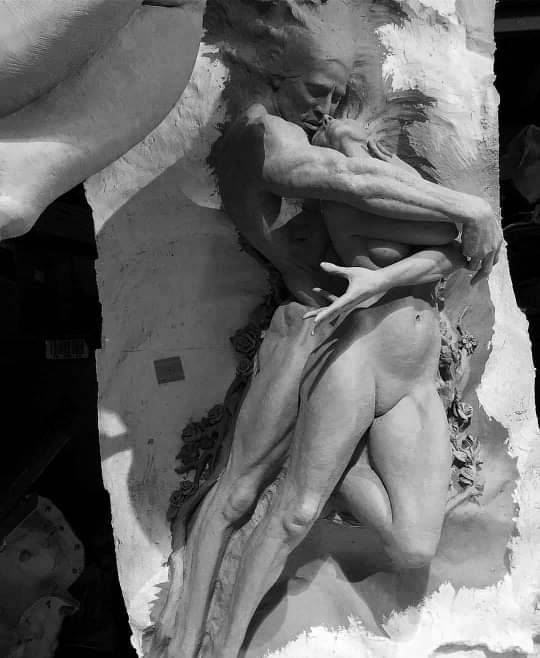
“You gave me peace in a lifetime of war.”
— Achilles
Sculpture by Mario Chiodo
#fate achilles#achilles pelides#achillestendon#the triumph of achilles#achilles#sculpture#love sculpture#mario chiodo#love you#love story#i love you#love yourselves#love your curves#love your body#love you always#couples
29 notes
·
View notes
Text
The day my docs office was apparently out of colored fiber tape! March 2022
#legcast#crippled#leg cast#castandcrutches#cast and crutches#crutches#ankle injury#on crutches#sprainedankle#ankle sprain#achillesruptured#achillesrupture#achillestendon#achilles#brokenleg#brokenfoot#brokenankle#foot injury#injuredfoot#injured#injury#toes
20 notes
·
View notes
Photo

Current Medical Therapies for Back Pain Relief include Stem cell therapy which may have the potential to be an alternative to invasive spine surgery.
Learn more http://bit.ly/2Ju6wLP
Free Consultation is available at (646) 480-1259
#Health Pain#Brooklyn#HuntersPoint#NYC#PainManagement#ACLinjuries#injuries#Achillestendon#Manhattan#Runnersknee#StatenIsland#Queens#BackPain#5thAvenue#Fitness#Health#SpineSurgery#ChryslerBuilding
2 notes
·
View notes
Text
Drop Jump Exercise (2 Feet) | Shock Training Plyometrics
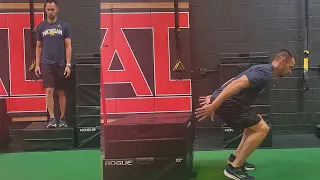
Drop Jump Exercise (2 Feet) | Shock Training Plyometrics Most people focus on plyometrics that involve jumping to higher and higher boxes trying to get more explosive. Drop Jump Exercises focus on the landing of the movement instead of the actual jump itself. What people forget about is that no matter the height of the jump you make, you'll always have to land from that jump. And if you do not feel comfortable landing from that jump, then you'll only have so many jumps before you start to feel tendon pain or injury. Shock training plyometrics are great for the health of the tendons that you use in support. Mainly the Achilles and patellar tendon. Drop jump landings should be included in the majority of peoples programs as it can be scaled appropriately to many ages!
#Plyometrics#ShockTraining#JumpTraining#TendonHealth#DropJumpExercises#ExplosiveLandings#InjuryPrevention#AchillesTendon#PatellarTendon#FitnessForAllAges
0 notes
Link
0 notes
Text
Update: Week 2 Achilles rupture surgery and mindfulness
Overall, I would say I’m doing well. I’m working my way through The Warrior’s Meditation and have learned an awesome vagal breathing technique that really helps with getting to a state of calm awareness, fast:
https://richardlhaight.com/vagal/
I’m in much better spirits and have learned that noticing and naming emotions go a long way to blunting their effect while allowing you to respond to them much more constructively than you normally might. I’ve continued my exercise routine and have continued to improve my core and upper body conditioning. I think my weight loss has slowed a bit but feels sustainable. My clothes fit better and I am stronger than before I ruptured my Achilles. I learned that you can always train and there is always something to improve, whatever the circumstances.
The doctor called on Wednesday and asked me to come in to have my stiches looked at before the holiday weekend. I ended up going on Thursday and it turns out that the stiches are healing great, my tendon is attached to the bone, it is connected on both sides, and everything appears to be progressing about as well as it possibly could. I’m no longer in constant pain and am to a place where it comes and goes. I’m more or less managing it with Tylenol at this point. Most importantly, my spirits are lifted, I’m getting around better, I’m optimistic for a full recovery with no complications, and am very much looking forward to getting back to kata.
Disaster nearly struck Saturday evening coming home from dinner in a rain storm. We had a friend visit from out of town (planned well before my injury). I had checked with my doctor to confirm that I can go out to dinner over the weekend and was given the all clear given that I was transitioned into a cast when my wound was checked and my pain was managed. On the way home from dinner, one of my crutches slipped on a wet wooden stair leading up to our house and I fell. I very easily could have reinjured myself or worse yet - injured something else. Instead, my body instinctively reacted and my training took over. My fall took the form of a roll onto our deck from the steps. I released both crutches, tucked my head, rolled, and absorbed the impact on my body with my arms slapping out to absorb any remaining impact. I protected my ankle/cast the entire time. My first Sensei taught us that they way we train in the dojo is how we will react in the street. This is true and something we should always be mindful of in our training.
While scary, I’m extremely happy with both the outcome and how I responded to the fall in the moment. The real lesson here is that however safe and confident we might feel, there is always risk. Mindfulness is important, particularly so when you are injured or stakes are otherwise really high. I’ll be making a concerted effort in the coming weeks to be more calmly aware of how I’m feeling (physically and mentally) and of my environment (physical or otherwise) with more deliberate thought guiding my actions based on awareness.
On the 8th, I go in to have my stitches removed and transition into a walking boot where I can start bearing some weight on the leg. I’m really grateful to have made it as far as I have and for the support and love of my wife (especially) and my family. Once I can stand, I’ll start working my basics back into my exercise routine and am thinking about getting a Wing Chun wooden dummy to be able to start working some conditioning and flow.

0 notes
